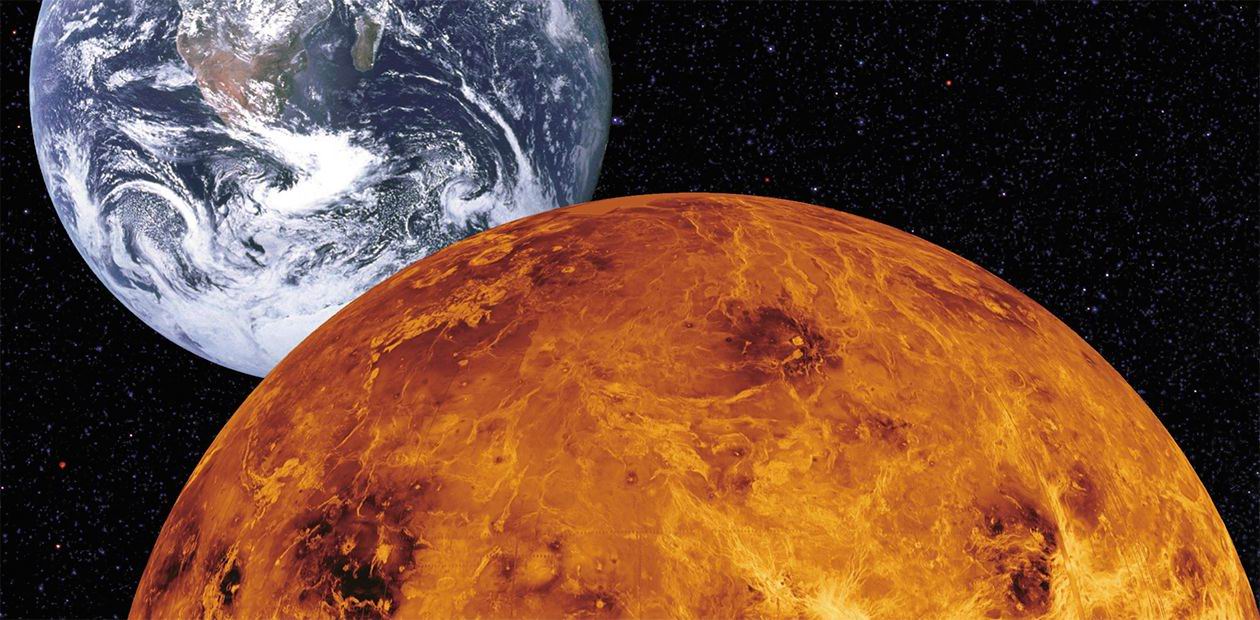Venus as possible future of the Earth
In April 2016, I gave a brief lecture course on geodynamics at Moscow State University. The final lecture was devoted to the evolution of the Earth and other planets of the Solar System. One of the audience asked if the Earth might one day have an atmosphere similar to the modern atmosphere of Venus, which is known to have a most peculiar—very hot (up to 450 °C) and dense—atmosphere composed mainly of CO2. My immediate response was: “Why not? There is a huge amount of carbonaceous rocks in the surface layers on the Earth, and if the upcoming heating of the Earth’s surface (when the Sun becomes a red giant) reaches a certain point, it may cause decarbonatization and a rapid growth of atmospheric CO2 and density. Thus, Venus can be a model of the Earth’s future.” Later I kept thinking about this impromptu idea and found additional arguments for this hypothesis as well as a possible scenario, which are presented in this article
To answer the question about the future of our planet, we should first look at the evolution of the Solar System as a whole because all its planets have a common origin and their outer shells are highly dependent on solar activity.
It is believed that the planets in our system formed from a giant protoplanetary gas-and-dust nebula at about the same time, roughly 4.6 billion years ago (Vityazev, 1983; Vityazev and Pechernikova, 2009; Ernst, 2014).
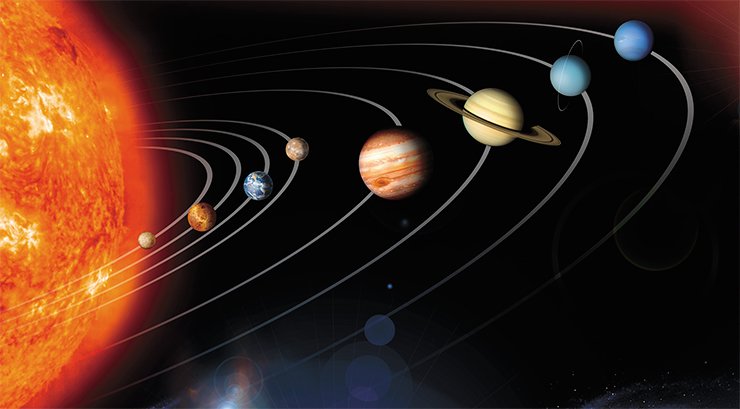
The further evolution of the planets is conventionally divided into six stages. However, the first three stages are specific to some of the terrestrial planets only—Mercury, Mars, and the Earth—and, to some extent, the Moon. These bodies were evolving largely in sync.
Speaking about Venus, we currently know very little about its early evolution because ancient geological structures on this planet are covered by young volcanic rocks and it is very difficult to explore its surface because of the dense cloud layer (Head, 2014; Ernst, 2014).
Birth of planets
The first stage in the formation of planets is accretion, i. e., thickening of a gas-and-dust nebula. According to simulations and isotopic analysis, this phase in the Earth’s evolution lasted about 100–120 million years (Vityazev and Pechernikova 2009; Kleine et al., 2002) and approximately the same time on Mars, Mercury, and, apparently, on Venus (Head, 2014; Ernst, 2014). The formation of the Moon followed a different path and was much faster: it separated from the Earth as a result of a collision with a hypothetical Mars-sized planet or restructuring of a double planet.
The primary atmosphere of the terrestrial planets also formed during the stage of accretion and evolved considerably at later stages. The heavy and dense atmosphere of the young Earth had no oxygen, but there was plenty of free hydrogen and methane, the simplest hydrocarbon. Gradually, along with the formation of the Ocean, it transformed into the modern low-density atmosphere of nitrogen and oxygen (Adushkin et al., 2007; Zharkov, 2013). As for Venus, we know nothing about its primary atmosphere, except that it came to look as it does today about 1 billion years ago as a result of active volcanic processes.
The stage of accretion and the subsequent early development, which was accompanied by meteorite bombardment on all the terrestrial planets, except Venus, and on the Moon, ended about 3.8 billion years ago, as evidenced by isotopic data for the Earth and the Moon. The next Stage II saw an end of the heavy meteorite bombardment on the Moon, Earth, and probably Mars (Bottke et al., 2012). The most distinct traces of this grand phenomenon are found on the atmosphereless Moon: judging by these traces, the fall of large meteorites was at a maximum 4.0–3.3 billion years ago, and the last of them fell on the lunar surface no later than 1 billion years ago (Hiesinger et al., 2011).
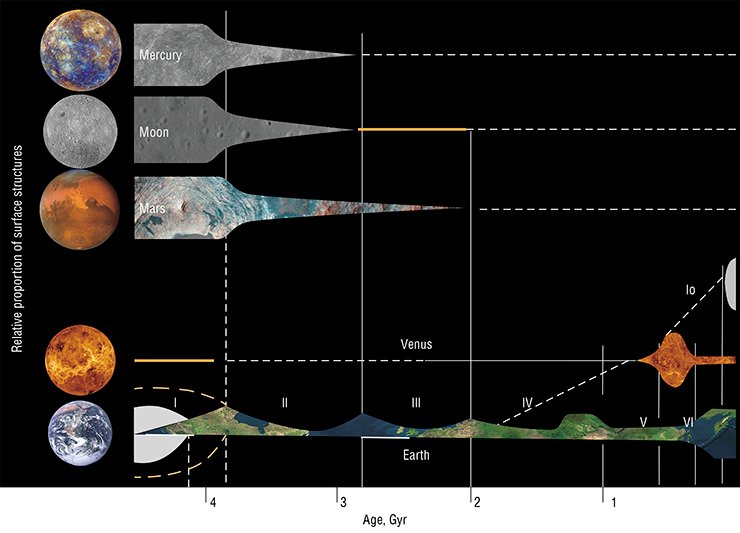
Thus, in the first 2.6 billion years, the formation processes on Mercury, Mars, the Earth, and the Moon were roughly similar. On Mars, plume magmatism, which is associated with the rise of hot molten magma from the planet’s interior, was over by the end of Stage III. On Mercury and the Moon, all the signs of magmatic activity had disappeared much earlier. However, the situation was different on the Earth and Venus. The evolution of the Earth’s oceans and ocean structures associated with the formation and change in the structure of currents in the upper mantle (asthenosphere) was reflected in the so-called plate tectonics, i. e., the movement of huge basalt slabs, which, like pieces of a puzzle, make up the Earth’s lithosphere (Stern, 2008; Dobretsov, 2009, 2010). Nothing like that was ever found on other planets, except Mars, which could have experienced, in the early stages of its evolution, phenomena similar to minor plates tectonics typical of the Earth in the early Proterozoic (Halliday et al., 2001; Ernst, 2014).
Unlike on the Earth, magmatic activity and related transformations of surface structures left distinct traces on Venus only in the late stages of the planet’s formation, as it was mentioned above.
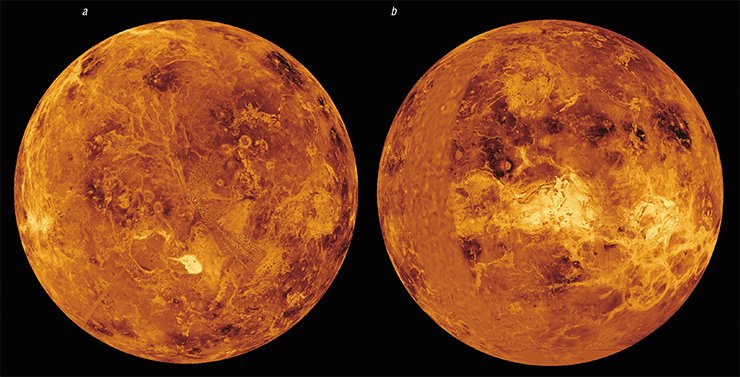
If we look at the patterns of the parallel processes on these two planets, we will see the following: the formation of the modern dense atmosphere of Venus began 1.8 to 1.0 billion years ago, amid the increase in the plume magmatism, and ended 0.8 to 0.5 billion years ago. At this time, the Earth saw the formation of the modern oceans, continents, and biosphere (Dobretsov, 2010, 2014). Over the past 200 million years, the Earth’s surface has come to look as it does today while the Venusian atmosphere and volcanism have been functioning at the same relatively stable level.
Thus, the evolution of the Solar System as a whole is a most complex phenomenon, whereby the termination of activity on one planet is accompanied by the beginning or an increase of activity on another planet. Nonetheless, there are certain similarities between the evolutionary stages on the different terrestrial planets. The reasons for these similarities are, firstly, the common origin of the planets, secondly, the intense meteorite bombardment that marked the end of the accretion process, and, finally, the plume magmatism, vivid manifestations of which were recorded periodically on the Earth throughout all its history, on Mars in the first 2 billion years, and on Venus during the last 1 billion years.
Below we take a closer look at the conditions underlying the formation of the specific atmosphere and magmatism on Venus and the possibility of similar phenomena in the late stages of the Earth’s evolution.
Shrouded in clouds of sulfuric acid
On the one hand, Venus is very similar to the Earth. Its radius is 0.95 of the Earth’s radius given almost the same average density of matter, which is why the mass of Venus is 0.8 of the Earth’s mass. However, Venus is closer to the Sun and rotates so slowly that the Venusian day is 225 Earth days. Not surprisingly, the Venusian surface became very hot over 4 billion years, and the planet developed an atmosphere that is totally different from that of the Earth.
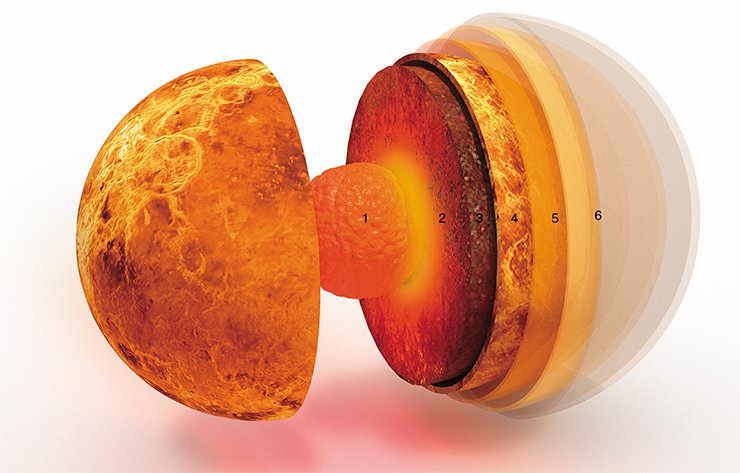
The data on Venus continue to be refined, but today it is known that the temperature at its surface is about 450 °C and the atmospheric pressure is 93(!) times the pressure on the Earth. The Venusian atmosphere is composed mainly of carbon dioxide (96.5 %) with a little nitrogen (3.5 %) and trace amounts of molecular oxygen, water, argon, hydrogen sulfide, and other compounds (Kondratiev et al., 1987; Avduevsky et al., 1995; Basilevsky and Head, 2003; Bertaux et al., 2007; Svedham et al., 2007). Interestingly, although the proportion of nitrogen in the Earth’s atmosphere is much higher, the Venusian atmosphere has four times more nitrogen in total mass because of the higher density and size of the atmosphere.
At an altitude of 40–65 km on the day side of Venus and 50–80 km on its night side, there is a cloud layer of small droplets (with a diameter of about 2 microns) of a highly concentrated sulfuric acid H2SO4 solution. Where does it come from? Presumably, this sulfuric acid is formed through a photochemical impact from sulfur dioxide SO2 emitted into the atmosphere by eruptions. The sulfur dioxide reacts with active atomic oxygen to form sulfuric acid (Basilevsky and Head, 2003; Bertaux et al., 2007):
SO2+O→SO3
SO3+H2O→H2SO4
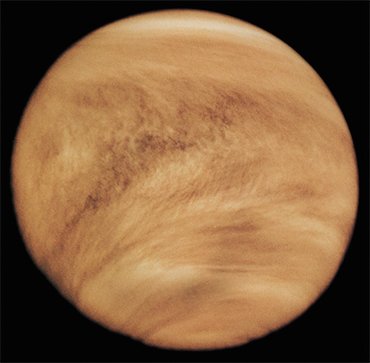 There are similar processes in the Earth’s atmosphere, but on a much smaller scale.
There are similar processes in the Earth’s atmosphere, but on a much smaller scale.
The Venusian atmosphere can be divided into the troposphere, the mesosphere, the thermosphere, and the ionosphere. The dense layer of the atmosphere—the troposphere—extends from the surface up to 65 km (the upper part of the cloud layer) and contains 99 % of the total mass of the atmosphere. The most part (90 %) of the Earth’s atmosphere is below an altitude of 10 km above the surface; for Venus it is 28 km. It is only at an altitude of 49.5 km that the pressure on Venus becomes the same as that on the Earth at sea level, and at an altitude of 54 km the temperature falls to the Earth’s level (21 °C) (Patzold et al., 2007). It is here, where there are water vapors and environmental conditions similar to those on the Earth, that life could exist, albeit in its simplest form (Bortman, et al., 2004). In the upper part of the troposphere, due to complex convection, there are strong polar vortices (Svedhem et al., 2007).
The next layer, which extends up to an altitude of 120 km, is the mesosphere. Its lower part (at an altitude of 62–73 km) coincides with the upper cloud layer, and the temperature here drops to –43 °C. The coldest (up to –108 °C) atmospheric layer on the day side is at an altitude of 73–95 km. The layer above the mesosphere is the thermosphere, which is characterized by the greatest temperature contrasts: here the temperature may rise to 127 °C on the day side and fall to –173 °C on the night side (Bertaux et al., 2007).
These temperature fluctuations are due to the patterns of circulation in the upper mesosphere and in the thermosphere. At altitudes of 90–150 km, air masses move from the day side to the night one, which is accompanied by the upwelling (rise) over the sunlit hemisphere and downwelling over the dark one. The night-time downwelling causes adiabatic heating, which produces a relatively warm (–40 °C) layer on the night side of the mesosphere at altitudes of 90–120 km.
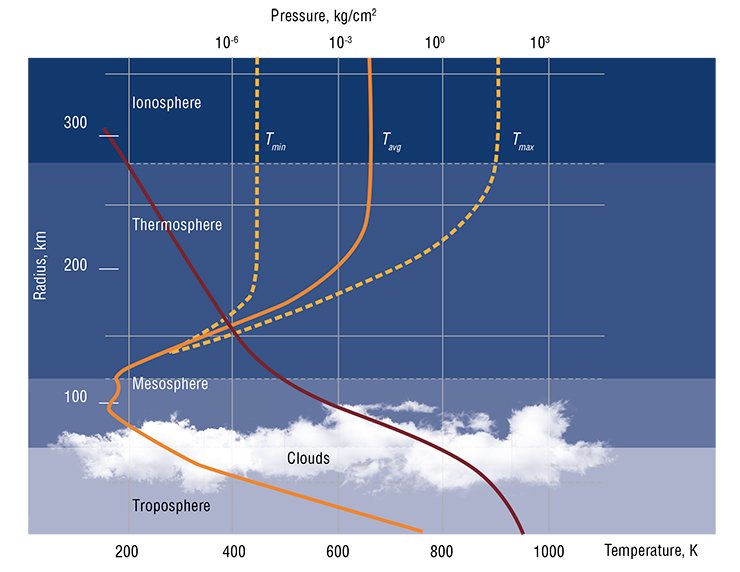
The thermosphere virtually coincides with the ionosphere, which is located at an altitude of 120–300 km and has an elongated shape. The two lower layers of the ionosphere contain mainly O2+ ions; the upper layer, О+; and electrons reach their maximum density in the medium layer (Patzold et al., 2007). Although Venus has a developed ionosphere, the planet’s magnetic field is very weak. The likely reason is the lack of convection in the core, although the intense plume magmatism on Venus appears to contradict this fact (Russel and Zhong et al., 2007).
One of the major unsolved scientific problems posed by Venus and its atmosphere is the virtually complete absence of atmospheric oxygen and water, although the planet is likely to have had an ocean 4–3 billion years ago. The scenario of the transition to the modern Venus must be related to the evolution of its magmatism. At least in the last billion years, the plume-type volcanic activity was the main formative process on Venus (Ernst, 2014).
Planet of volcanoes
The age of the most ancient volcanic rocks on Venus, which are the remnants of an ancient foundation and crystalline plateaus, is 0.8–2.0 billion years, and the age of the majority of volcanites is estimated at 500–800 million years (Ernst, 2014; Bjonnes et al., 2012; Basilevsky and Head, 2001, 2002).
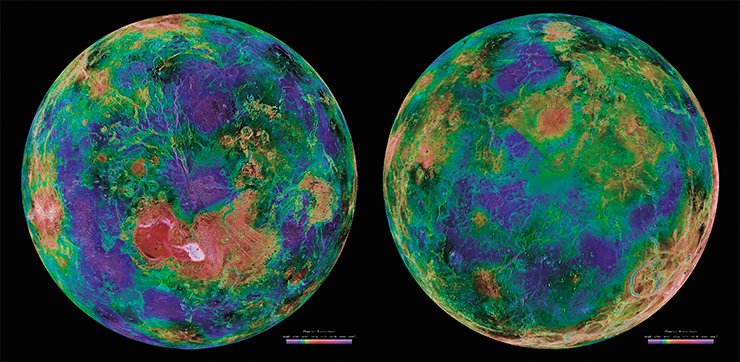
A careful study of images of the Venus surface revealed 168 single large volcanoes with diameters above 100 km, 289 smaller volcanoes, and 208 volcanic fields with a total area more than 50,000 km2. The grandest volcanic fields with an area of 0.2–1.6 million km2 occupy more than one-tenth of the area of all the Venusian plains, the prevailing landscape feature on Venus (Crumpler and Aubell, 2000; Magee and Head, 2011; Davey et al., 2013.).
The other 140 fields of a smaller area (about 100 km2) have a distinct radial structure with a large volcano or a corona (a large surface uplift surrounded by a trough, i. e., a linear depression with a flat or sometimes slightly convex or concave central part) at the center. The majority of large lava fields are associated with extension structures such as rifts, rift-like structures, etc., and must have formed as a result of a horizontal extension of the lithosphere. Of particular interest are the systems of radial fractures and graben, which are very similar to the radial dike systems on the Earth, which are associated with mantle plumes, i. e., narrow hot flows of matter rising from the mantle to the surface.
The first such fields were discovered on Venus by the Magellan mission, when NASA’s interplanetary space probe made the first full-scale radar mapping of the planet’s surface (Grosfils and Head, 1994). It was found that the radius of these systems on Venus is much greater than on the Earth and can reach 2,500 km. Recently, scientists have suggested the existence of an even greater radial system of fractures and graben on the southern edge of the Venusian Aphrodite Terra with the unique Artemis Corona at the center (Ernst et al., 2003; Krasilnikov and Head, 2003).
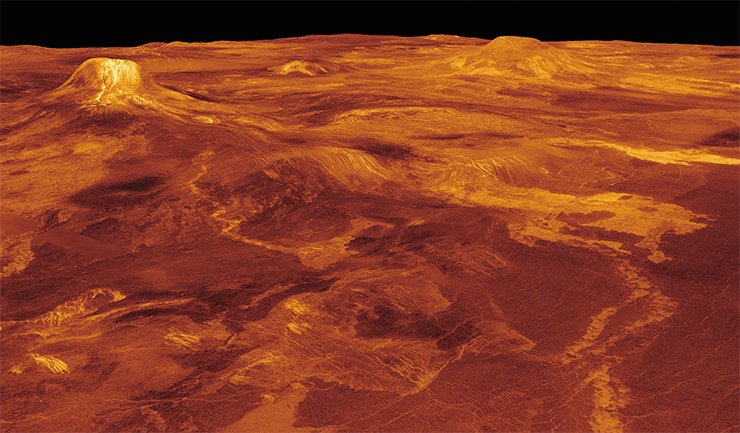
Artemis is a deformed corona with an outer trough of more than 5,000 km in diameter, and the diameter of the radial fracture–dike system itself is 12,000 km (Hansen et al., 2000). It is believed that the system formed on the thin lithosphere and, in this sense, could have been an analogue of the terrestrial oceanic mantle superplumes in the Indian and Pacific Oceans, where the reconstructed diameter of the superplume is close to 10,000 km (Dobretsov, 2010, 2011; Ernst, 2014).
Artemis Corona and some of the large accumulations of volcanoes may also be plume clusters (Ernst, 2014). The most likely candidate for this role is the BAT region (the area between Beta, Atla, and Themis regions), which occupies 20 % of the Venusian surface, where there are three volcanic clusters, more than 60 large volcanoes, hundreds of coronas and plenty of rifts of various sizes (Basilevsky and Head, 2000; Ernst, 2014).
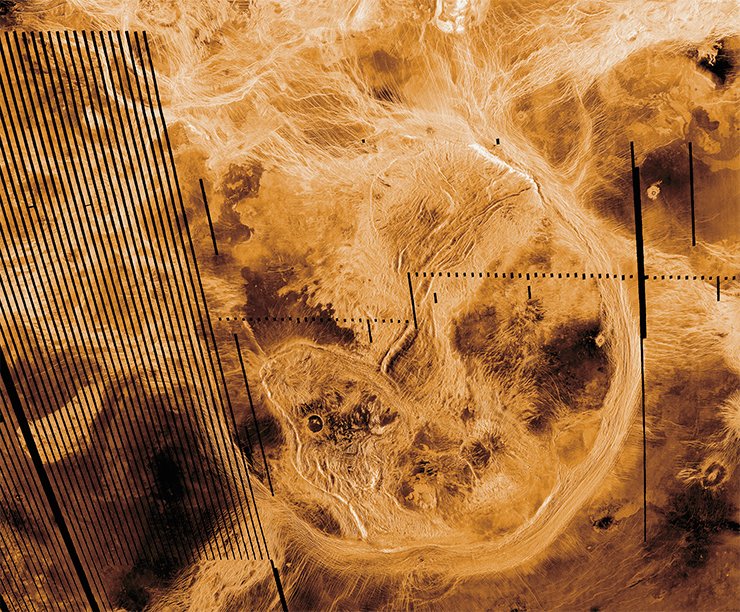
It is believed that almost all the volcanoes on Venus are basaltic structures with an admixture of alkaline and acidic rocks; however, alkaline and carbonaceous rocks may account for a more substantial share in their composition (Ernst, 2014). This is confirmed by the data on the Venusian surface, which were obtained by space probes, and by telescopic observations. In March 2016, Richard Ernst gave lectures at Novosibirsk State University, where he presented data leading to the conclusion that the highly liquid streams and lakes on Venus are composed mainly of carbonaceous rocks; however, there is still no direct evidence that these rocks account for a substantial share in the composition of volcanic products on Venus. These rocks can be an important and stable source of CO2 in the atmosphere and ensure its stable content over a billion years despite the dissociation reactions and the intense convection.
On the Earth, any large plume province always has alkaline rocks and carbonatites (Buchan and Ernst, 2001; Ernst, 2014). On Venus, their proportion can be much higher because of the higher temperature in the interior as well as on the surface and due to certain differences in the composition of the inner shells of these planets. Plume activity has always had a strong impact on the composition of the Ocean and biosphere throughout the Earth’s history. A similar impact on the atmosphere and the origin of life on Venus could have come from Venusian plumes, but this issue requires further research.
Terrestrial scenario
Returning to the question of the Earth’s future, we now discuss the fascinating results obtained by a team of European astronomers and geologists who explored the evolution of the Earth and its biosphere over the past 2.5 and for the next 1.5 billion years, which I have often quoted (Bounama et al., 2004; Dobretsov, 2009, 2013).
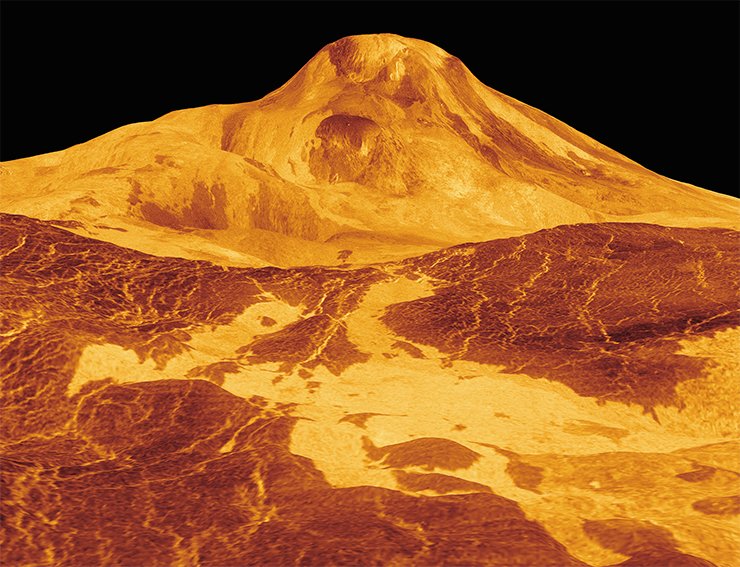
According to these studies, the main regulator of the surface conditions on the Earth and the evolution of its biosphere has been and will be the average temperature of the Earth’s surface. Two and a half billion years ago, when this temperature was 48–50 °С, the biosphere consisted solely of prokaryotes (bacteria and archaea), the simplest single-celled organisms, with a total biomass of 400–500 Gt (gigatons) of carbon. Seven hundred million years after, the surface temperature dropped below 30 °С, leading to the appearance of eukaryotes, i. e., organisms with a well-defined cell nucleus. Roughly 1 billion years ago, the mass of the biosphere reached more than 1,000 Gt of carbon, of which the eukaryotes accounted for 600 Gt.
Then, the Earth experienced a rapid cooling to 0–10 °С, which resulted in the greatest glaciations throughout the planet’s history; the glacial period ended 550–600 million years ago (Dobretsov and Chumakov, 2001; Dobretsov, 2009). Of course, the biomass decreased by almost a half in this period, but the decline was replaced by a rapid growth, which culminated in the second peak about 540 million years ago. Most importantly, it was then that higher organisms—multicellular eukaryotes with well-differentiated tissues and organs—appeared and began to evolve rapidly.
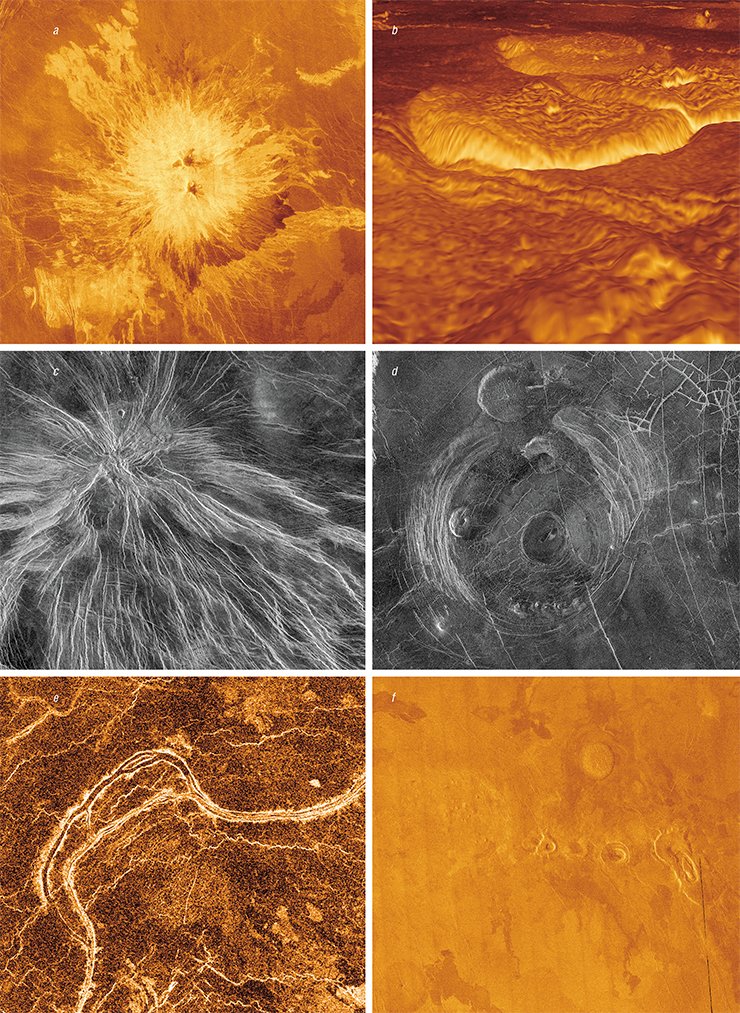
In the subsequent period and up to the present day, the average temperature has not fallen below 10 °С and risen above 20–25 °С. It can be assumed that in the next 550 million years, the Earth’s surface temperature will continue to fluctuate amid a general increasing trend to values around 30 °С. As a result, by the end of this period, the mass of the biosphere will decrease to the levels reached 2.0–2.5 billion years ago.
Subsequently, the surface temperature will be increasing rapidly because of the expansion of the Sun and increased insolation due to the Sun becoming a red giant. When the temperature substantially exceeds 30 °С, higher multicellular organisms will disappear, and at 40 °С, all the other eukaryotes. The majority of modern prokaryote species will disappear when the temperature rises above 70 °С, and the further increase will result in the disappearance of all life forms based on RNA and DNA hydrocarbon chains (Bounama et al., 2014).
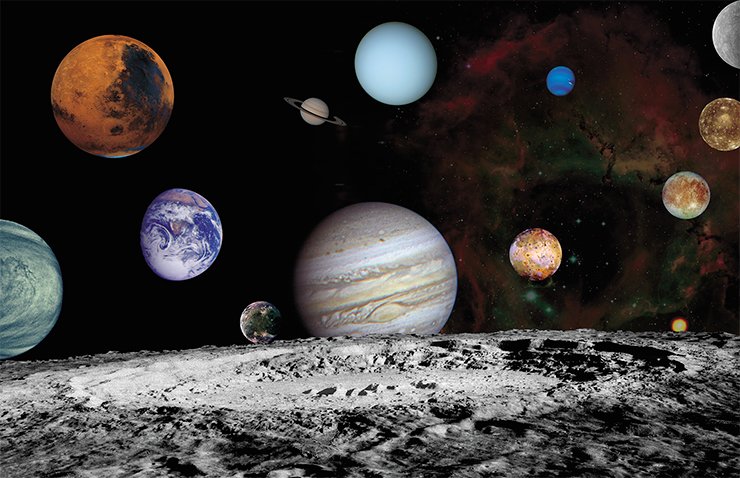
Then, the Earth’s surface temperature will most likely continue to grow to exceed 100 °С in 1.5–1.7 billion years. This will mark the beginning of the final stage in the transition to a state similar to the modern Venus. The oceans will begin to boil and evaporate, leading to a thick cloud layer. The dramatic increase in the greenhouse effect will boost the further heating of the Earth’s surface. The increase in the temperature to 400–450 °С and pressure to 50–60 atmospheres will lead to the oxidization of kerogen, i. e., scattered and concentrated organic matter, and to decarbonatization, i. e., the decomposition of minerals such as dolomite and calcium carbonate (CaCO3→CaO+CO2, CaMg(CO3)2→ CaO+MgO+2CO2). As a result of interactions with silica, these reactions also occur at lower temperatures (around 450 °C) and a pressure of 60 atmospheres (CaCO3+ SiO2→CaSiO3+CO2, CaMg(CO3)2 + 2SiO2→ CaMgSi2O6 + 2CO2).
As a result, the crust will be enriched in calcium and magnesium silicates and the atmosphere will be losing oxygen and getting more carbon dioxide and water, which will be transported into the Earth’s outer shell and rapidly diffuse into space.
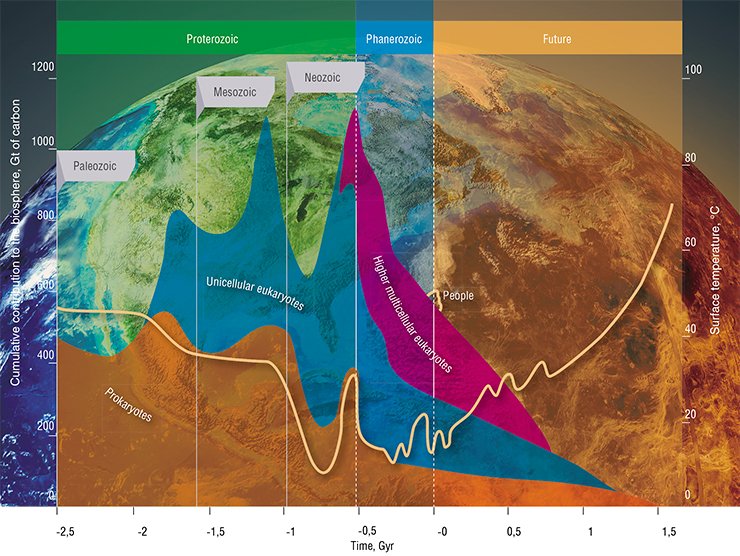
These changes are similar to the evolution of the Earth’s atmosphere at an early stage, but they go in the opposite direction (Dobretsov, 2010, 2014). When the Earth was cooling, its primary atmosphere was losing its density, there were oxidation processes, and water vapor and carbon dioxide were isolated in the form of the hydrosphere and carbonate sediments. The heating of the planet should trigger the reverse processes, which will lead to an increase in the atmospheric density due to the increased concentrations of carbon dioxide and the loss of free oxygen and water. As to the time limits, the Earth was cooling for 5 billion years after the accretion; however, it may become a second Venus in 1.5 billion years after the beginning of the temperature rise.
Being closer to the Sun, Venus was cooling more slowly and to a lesser extent. The planet began to heat again in the early Proterozoic, i. e., about 2.5 billion years ago, and 0.5–1.5 billion years after, its atmosphere came to look as it does today. Roughly 6 billion years after the formation of the planets, the conditions on the Earth and Venus will again be similar, although this is, of course, a very approximate estimate.
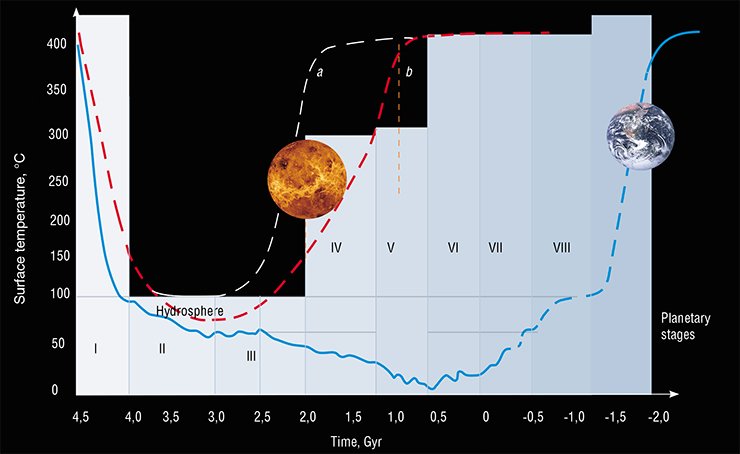
The possibility of development of a biosphere on Venus, in an environment seemingly incompatible with life, requires special attention. By the way, the Earth’s biosphere had gone through a series of watershed moments to prove its exceptional tenacity of life. It is believed that life on the Earth took a foothold and began developing around 3.9 billion years ago; before that time, it could have originated more than once, but was destroyed each time as a result of intensive meteorite bombardment (Zavarzin, 2009; Rozanov, 2009). The Earth’s biosphere had to undergo substantial transformations during major glaciations and catastrophic plume eruptions, such as the Siberian Traps (Hoffman and Schred, 2002; Maruyama and Liou, 2005; Wignall, 2007; Dobretsov, 2009; Sobolev et al., 2011).
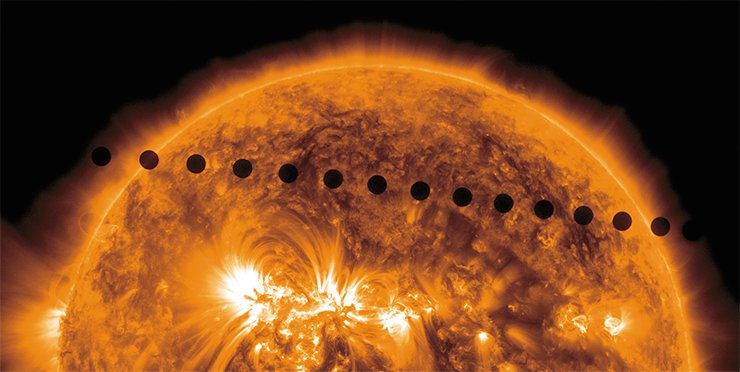
On the young Venus, there could have been a long and slow parallel evolution of life and the planet’s surface, and protozoal organisms such as bacteria could have migrated from the surface to the cloud layer, where there was water and elements necessary for life. These bacteria could have concentrated in areas with lower levels of H2SO4 and even actively maintained these levels by utilizing solar energy. One piece of indirect evidence for the existence of living organisms on Venus is the detection of carbonyl sulfide CO(S) in its clouds: on the Earth, bacteria are involved in the formation of this compound (David, 2003).
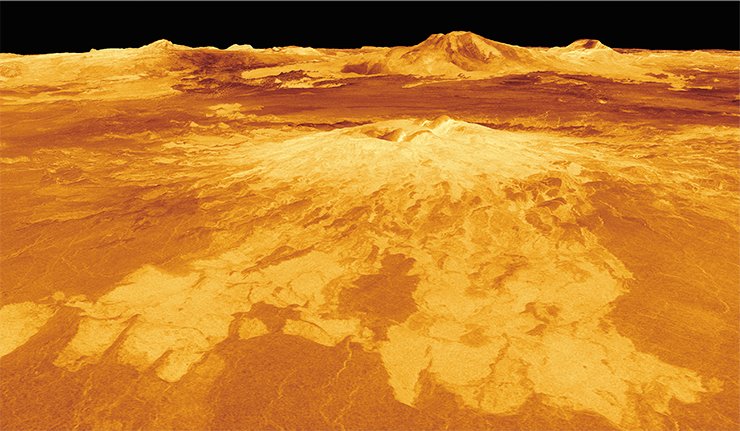
Speaking about the possible future of the Earth, in the case of the worst Venusian scenario, people could move in advance to the Moon or Mars and bacteria could migrate to the cloud layer, as they likely did on Venus. By the way, researchers have discovered viable specific bacteria in terrestrial clouds (Landis, 2003; David, 2003). However, the most mind-blowing outcomes are the development of an alternative carbon–oxygen form of life on the Earth when carbon makes a transition to a tetrahedral coordination, like the one in diamonds, and the emergence of carbon–oxygen chains similar to the silicate ones of pyroxenes and amphiboles, which contain nitrogen and phosphorus and are stable at high temperatures. There are theoretical predictions that this carbon coordination can emerge at very high pressures yet may exist in living organisms under milder conditions as well. However, these are, of course, only preliminary ideas...
References
Adushkin V. V. and Vityazev A. V. The origin and evolution of the Earth: A contemporary view // Herald Russ. Acad. Sci. 2007. V. 77. N. 3. P. 232—238.
Bortman H. Was Venus alive? The signs are probably there // Astro-biology Mag. 2004. N 8.
Bounama C., Blok W. von, Franck S. Das Ende des Raumschiffs Erde // Spectrum der Wessen schaft. October. 2004. P. 100–104.
Dobretsov N. L. Global’naya geodinamicheskaya evolutsiya Zemli I global’nye geodinamicheskie modeli (Global geodynamic evolution of the Earth and global geodynamic models // Geologiya i geofizika. 2010. V. 51. N. 6. P. 761—784 [in Russian].Ernst R. E. Large igneous provinces. Cambridge Univ. Press. 2014. P. 653.
Grinspoon D. Venus Revealed: A new look below the clouds // Reading Mass. 1998. ISBN 978 – 0201328394.
Head J. W. The geologic evolution of Venus: insights into Earth history // Geology. 2014. V. 42. P. 95—96.
Problemy proiskhozhdeniya zhizni (The Origin of Life). Ross. Akad. Nauk. Moscow. PIN. 2009. P. 168—184 [in Russian].Svedhem H., Titov D. V., Taylor F. C, Witasseo. Venus a more Earth–like planet // Nature. 2007. V. 450. P. 629—632.
Wignall P. B. The link between large igneous province eruptions and mass extinction // Elements. 2005. V. 1. P. 293—297.
Zasova L. V., Morozov V. N., Minkin V. I., and Maiorov B. S. Stroenie atmosphery Venery ot poverkhnosti do 100 km vysoty (Structure of the Venusian atmosphere from the surface up to a height of 100 km) // Kosmicheskie issledovaniya. 2006. N. 44. P. 381—400 [in Russian].
Zharkov V. I. Vnutrennee stroenie Zemli i planet (Internal Structure of the Earth and Planets). Moscow. Nauka i obrazovaniye. 2013. [in Russian].


